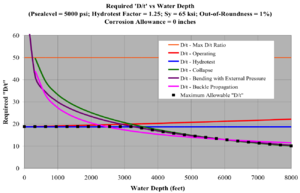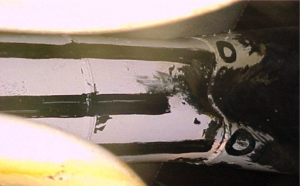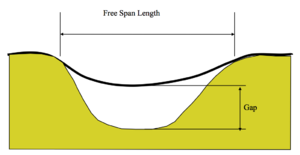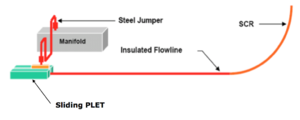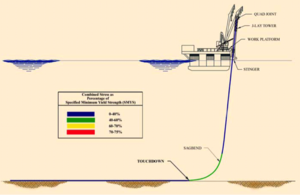Pipelines
Jump to navigation
Jump to search
The printable version is no longer supported and may have rendering errors. Please update your browser bookmarks and please use the default browser print function instead.
Design Codes and Regulatory Requirements
- Design shall be governed by the most stringent requirements defined by:
- Local regulations (e.g. MMS – US, HSE – UK)
- Project requirements
- Company standards and specifications
- Local codes and standards
Route Selection
- Route influenced by
- Obstructions such as rocks, mud slides, pipelines, platforms, etc.
- Other users of the seabed
- Limitations of construction equipment
- Need detailed survey data to better understand surrounding environment
- Two main types of route survey:
- Geophysical - shape of seabed and soil types
- Geotechnical - strength of seabed soil
- Survey data are inputs for detailed design and installation
- Two main types of route survey:
Mechanical Design
Wall Thichness
- Pressure containment
- Static and dynamic loading
- Local buckling (external pressure design)
- Design codes (U.S. applications)
- ASME B31.4 (liquid pipeline systems application)
- ASME B31.8 (gas transportation application)
- API RP 1111 (hydrocarbons transportation application)
- Others - Flavor of the region
- Collapse – Bending moment and external pressure
Span Assessment
- Maximum allowable span length
- Static stress Analysis
- Static stress criteria
- Installation, hydrotest and operation conditions
- Vortex induced vibration (VIV)
- Fatigue criteria
- Operation conditions
- Static stress Analysis
Span Mitigation
- Mitigation strategies:
- Sandbags
- Concrete mattresses
- Structure supports
- Trenching
- Rock dumping
- VIV Suppression - if the maximum span length is governed by VIV and the static stress criteria is satisfied
Thermal Expansion and Buckling
- Middle-line expansion
- Upheaval buckling
- Buried pipelines
- Lateral buckling
- Pipeline laid on seabed
- End expansion - fixed end vs. free end
- Pipe burial and rock dumping
- Thermal expansion loops
- Lateral buckling control - buckle initiator
- Pipeline installed over a sleeper
- Pipeline installed with buoyancy (add to previous)
On-Bottom Stability
- Pipeline stability - Analysis to ensure pipeline
- Movement is within allowable tolerances for all foreseeable environmental/operational conditions
- Metocean Data - Design currents and waves
- Hydrodynamic Forces
- Drag, Inertial and Lift
- Soil Lateral Resistance
- Soil friction
- Resistance due to pipe embedment
- Analysis tool (e.g. American Gas Association on-bottom stability program)
- Mitigation
- Concrete weight coating or just increase wall thickness
- Trenching
- Weight clamps
- Anchoring
Material Selection
- Basic Considerations:
- Strength
- Pressure
- Tension
- Environment
- Material compatibility with Internal Content
- Availability of Material
- Stell, CRA, Flexibles
- Pipeline Life or Afterlife
- Strength
Corrosion
- Types of Corrosion
- Internal
- External
- Mitigation of Corrosion by Coatings
- Cathodic Protection
- Internal Corrosion Control
Internal Corrosion Protection
- Material selection
- Use corrosion inhibitor chemicals
- Consider chemical effects on all parts throughout the system
- Internally coat the line with corrosion resistant material
- Can be costly
- May have a limited life
- Monitor corrosion rate
- Online corrosion monitoring (corrosion spools, corrosion coupons, iron counts)
- Intelligent pigging
External Corrosion Protection
- External corrosion coating
- Fusion Bonded Epoxy (FBE)
- Three layer Polyethylene (3LPE)
- Elastomeric Coatings: Polychloroprene, ethylene propylene diamine (EPDM)
- Cathodic Protection
- Must be in a continuous conductive medium
- Sized to accommodate up to 25% coating breakdown or less over field life
- May be impressed current or sacrificial anodes
Installation
- Installation Methods
- S-Lay Vessel
- J-Lay Vessel
- Reel-Lay Vessel
S-Lay Method
- Suspended pipe shaped like S-Curve
- Pipeline must be tensioned to hold its shape & avoid buckling
- Pipe laying up to 60"
- 40' or 80' pipe sections welded together horizontally onboard vessel
J-Lay Method
- Suspended pipe shaped like letter "J"
- Almost vertical tower supports pipe onboard vessel
- Pipe enters water at high entry angle - no overbend
- Deep water applications
Reel-Lay Method
- Pipe is welded together onshore and spooled onto a large diameter reel - plastically yielded
- Pipe must be straightened offshore during un-spooling
Pipeline Testing and Commissioning
- Hydrotesting
- Defined by code, regulation and project requirements
- Serves as final pipeline integrity check
- Usually tied to installer's credibility
- Commissioning is a planned process to prepare the pipeline for operations phrase.
